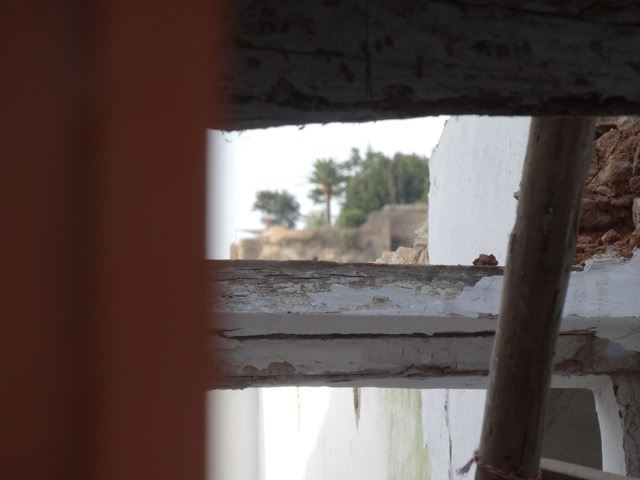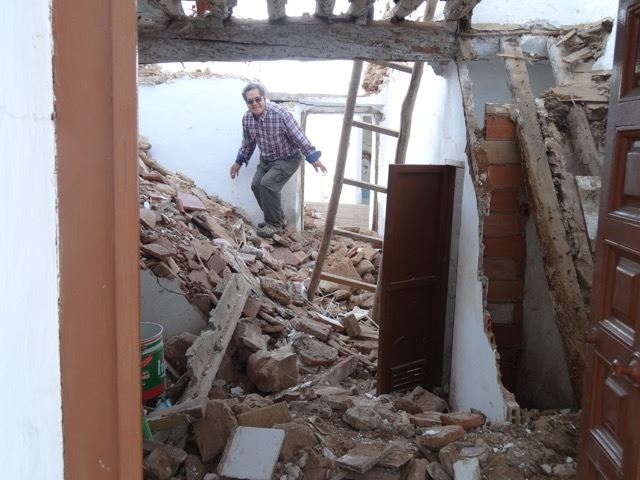
To demolish a house should be a rather easy affair, but not so in southern Spain. Certainly not when the house is in town where all houses are attached, so you virtually own a slice of a sidewalk with shared walls. If your house in addition is located in the historic and thus protected area, expect trouble. Our house was both; a slice with vaguely defined neighbouring walls sitting right where Ronda’s old Arab graveyard used to be located up to the late 15th century. We were at peace with our house’s friendly ghosts and felt privileged to live in such an historic area, but knew that this could cause a few delays.
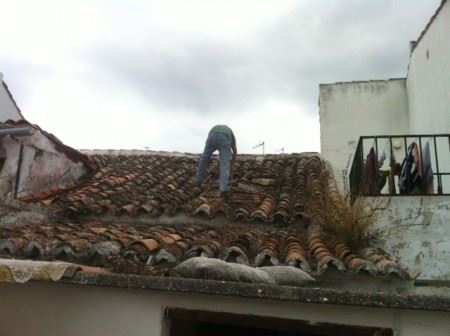
Cut to two years later… Having our building permit in hand, the first thing we had to do was to apply for another permit, or to be precise, a permit extension. Not for the building, nor the demolishing, but for the archaeological dig, which they so generously had given us two weeks to complete. We’d gladly do as they said, had it not been for the rotten beams and partially caved-in roof, the treacherous stairs and shaky floors that all had to be removed, and outer walls that had to be properly checked and secured before an archaeological dig could be safely performed. But the building experts in Malaga had not foreseen this practical impossibility.
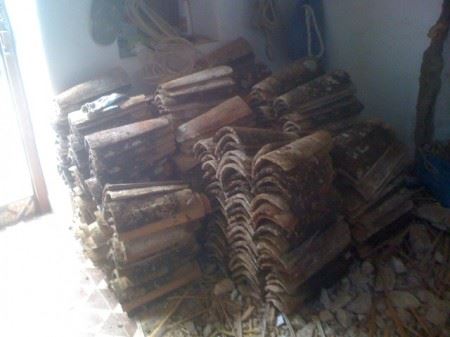 Thankfully, the extension was given without too much delay. We could in principle begin the de-construction work. There was only one more hitch. In the province of Malaga, (and no other place in Spain, as far as we know), archaeologists are only allowed to work on one project at the time. Architects and builders can juggle a handful projects to allow for technical delays, but not archaeologist. This law must exist to assure that archaeologists will starve if a work site is inevitably stalled or delayed. We contacted Ronda’s two archaeologists, who both had projects for a year or so. We started looking for archaeologists in other towns, all of whom would come with lengthy timelines and extensive projects proposals, as if we were to dig out an entire Roman village and not a 3-meter by 10-meter slice of a house at a depth of barely 40 centimeters! After a few too many ‘special price just for you’ proposals, we found an archaeologist in a nearby town who miraculously had a gap in his schedule merely two months away. We were ready to kiss his dusty sandals and signed the deal on the spot. The work could FINALLY begin.
Thankfully, the extension was given without too much delay. We could in principle begin the de-construction work. There was only one more hitch. In the province of Malaga, (and no other place in Spain, as far as we know), archaeologists are only allowed to work on one project at the time. Architects and builders can juggle a handful projects to allow for technical delays, but not archaeologist. This law must exist to assure that archaeologists will starve if a work site is inevitably stalled or delayed. We contacted Ronda’s two archaeologists, who both had projects for a year or so. We started looking for archaeologists in other towns, all of whom would come with lengthy timelines and extensive projects proposals, as if we were to dig out an entire Roman village and not a 3-meter by 10-meter slice of a house at a depth of barely 40 centimeters! After a few too many ‘special price just for you’ proposals, we found an archaeologist in a nearby town who miraculously had a gap in his schedule merely two months away. We were ready to kiss his dusty sandals and signed the deal on the spot. The work could FINALLY begin.
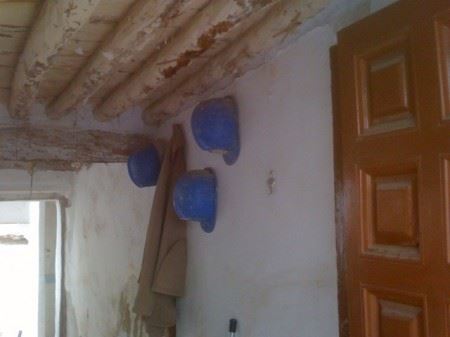 By this time we had spoken to more constructors than we cared to remember and had found a builder whom we both felt would do a good job. He was local, second generation builder and had a family, so we knew he would not run off on us if there were any problems. Such are important things to consider when somebody is supposed to build you a house in a foreign country. His team consisted of a group of rugged men, including three very capable brothers with their specialty skills. They worked with us for almost eight months, through thick and thin as they say and we never regretted our choice. Anyhow, I am getting ahead of myself. We had not even started digging…
By this time we had spoken to more constructors than we cared to remember and had found a builder whom we both felt would do a good job. He was local, second generation builder and had a family, so we knew he would not run off on us if there were any problems. Such are important things to consider when somebody is supposed to build you a house in a foreign country. His team consisted of a group of rugged men, including three very capable brothers with their specialty skills. They worked with us for almost eight months, through thick and thin as they say and we never regretted our choice. Anyhow, I am getting ahead of myself. We had not even started digging…
The thing with an old house is that one never knows what the project will entail until things are brought to the open. Walls that seem sound initially may crumble once indefinite layers of chalk paint are removed. Beams will turn to sawdust. Neighbours may have built illegal extensions and the ground may not be as solid as initially thought. There are always surprises with old houses and surprises generally cost, time and money.
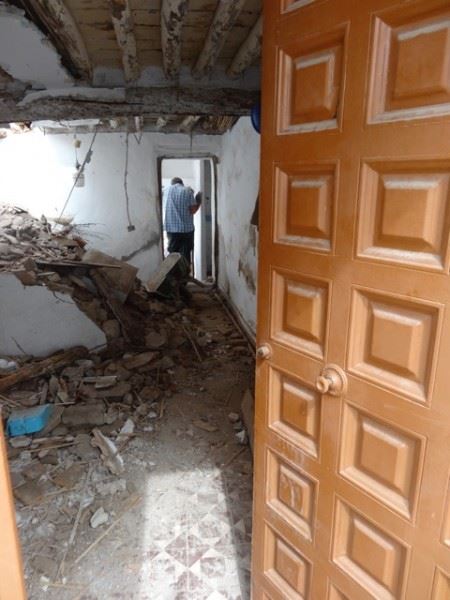 Our builders ‘moved in’, putting up an official construction sign and hanging up the legally required hard hats on the wall, never to be used as far as we detected during the entire process. Their first step was to remove the old Arab style roof tiles, one by one, carefully storing them aside to be mounted again once the new roof was built underneath. Re-using the old tiles is required in Ronda’s historic area, and both my husband and I loved the look of these patina and moss covered terra cotta tiles. Working from top to bottom, the next step was to remove all inner walls and then the dividing floors. Finally, the crumbling stairs to the second floor were removed and only the skeleton framework of three old supporting beams remained. Our architect, building inspector and builders met on the site, agreeing that things had to be taken very slowly or the sidewalls could cave in.
Our builders ‘moved in’, putting up an official construction sign and hanging up the legally required hard hats on the wall, never to be used as far as we detected during the entire process. Their first step was to remove the old Arab style roof tiles, one by one, carefully storing them aside to be mounted again once the new roof was built underneath. Re-using the old tiles is required in Ronda’s historic area, and both my husband and I loved the look of these patina and moss covered terra cotta tiles. Working from top to bottom, the next step was to remove all inner walls and then the dividing floors. Finally, the crumbling stairs to the second floor were removed and only the skeleton framework of three old supporting beams remained. Our architect, building inspector and builders met on the site, agreeing that things had to be taken very slowly or the sidewalls could cave in.
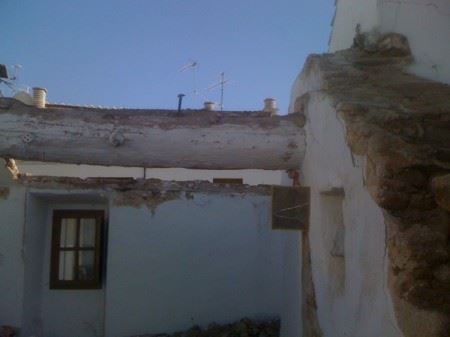 As our house and the 2-meter wide slice of house to the right were once a single dwelling, probably split by siblings’ inheritance, we knew that this wall would need strengthening. We also shared the ridge beam with them, so the builders put up support buttresses next door before cutting the final beams. On the left side of our house is a multi-housing unit, which shot up during the building boom some 20 years ago. Once we stared thinning our meter-thick exterior wall, we discovered that the complex had not, as law requires, built their own exterior wall against ours, but merely leant their cross-walls against ours and ran all their cables and water pipes down our wall. As our house had been abandoned for a few decades, nobody was there to protest and we could not insist they build their wall now, 20 years later. We wrote to their strata council and were given permission to tear down and properly re-build the entire sidewall, of course out of our pocket, never mind them having broken the law. Ironically, during the entire construction period, the only complaint came from the one neighbour who had an illegal balcony leaning on our wall. Details, details…
As our house and the 2-meter wide slice of house to the right were once a single dwelling, probably split by siblings’ inheritance, we knew that this wall would need strengthening. We also shared the ridge beam with them, so the builders put up support buttresses next door before cutting the final beams. On the left side of our house is a multi-housing unit, which shot up during the building boom some 20 years ago. Once we stared thinning our meter-thick exterior wall, we discovered that the complex had not, as law requires, built their own exterior wall against ours, but merely leant their cross-walls against ours and ran all their cables and water pipes down our wall. As our house had been abandoned for a few decades, nobody was there to protest and we could not insist they build their wall now, 20 years later. We wrote to their strata council and were given permission to tear down and properly re-build the entire sidewall, of course out of our pocket, never mind them having broken the law. Ironically, during the entire construction period, the only complaint came from the one neighbour who had an illegal balcony leaning on our wall. Details, details…
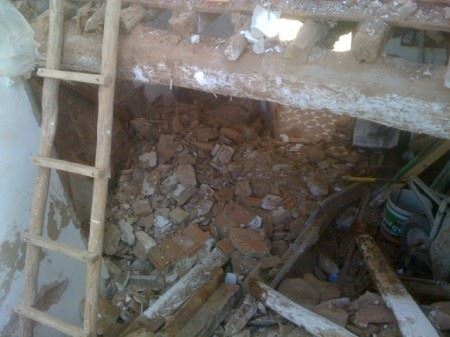 We were now down to the ground level. We kept what could be saved of the psychedelic hydraulic tiles that now are back in fashion which covered main floor, later donated to our builders storage, to his wife’s great annoyance. The basement and the upper floor had old terra cotta tiles, though only a dozen could be saved after indefinite years of use and abuse. Nobody actually knows how old our house is. The city plans said that it was built in 1949, which was likely when they did the last ‘renovation’.
We were now down to the ground level. We kept what could be saved of the psychedelic hydraulic tiles that now are back in fashion which covered main floor, later donated to our builders storage, to his wife’s great annoyance. The basement and the upper floor had old terra cotta tiles, though only a dozen could be saved after indefinite years of use and abuse. Nobody actually knows how old our house is. The city plans said that it was built in 1949, which was likely when they did the last ‘renovation’.
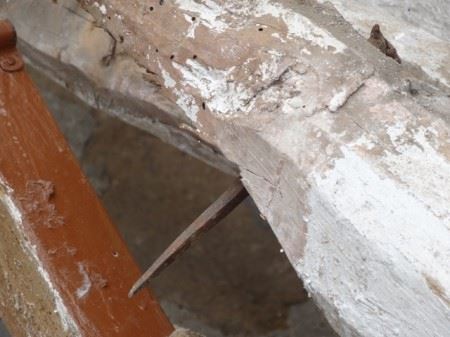
Judging by the enormous hand-forged nails (enough to make a Viking jealous), at least part of the house must have been there for centuries. These types of houses have been changed, added to and morphed throughout generations, as families grew or shrunk. Our seemingly solid outer walls, a meter thick in places, were built by sticking together a mixture of oversized boulders, small rocks and red earth which once may have been clay. Equally, the house had no foundation. The walls were standing straight onto the soil with the floor tiles sitting on the earth. No strange it was a bit of a humidity problem…
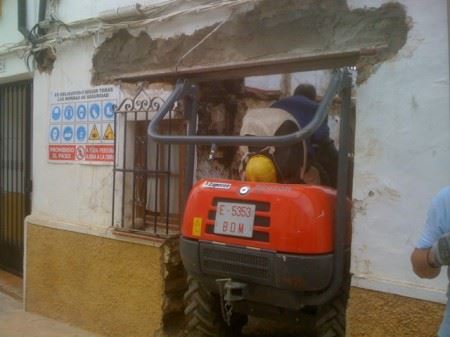 The facades of houses in protected areas are supposed to be left undisturbed. This proposed a problem, as no mechanical digger could fit through our narrow front door. We had to ask for permission, once again, this time to remove the door and make a hole just wide enough for a excavator to enter. How the operator managed to actually turn the digger around inside a house no wider than 3 meter is a mystery and should in itself earn him a medal.
The facades of houses in protected areas are supposed to be left undisturbed. This proposed a problem, as no mechanical digger could fit through our narrow front door. We had to ask for permission, once again, this time to remove the door and make a hole just wide enough for a excavator to enter. How the operator managed to actually turn the digger around inside a house no wider than 3 meter is a mystery and should in itself earn him a medal.
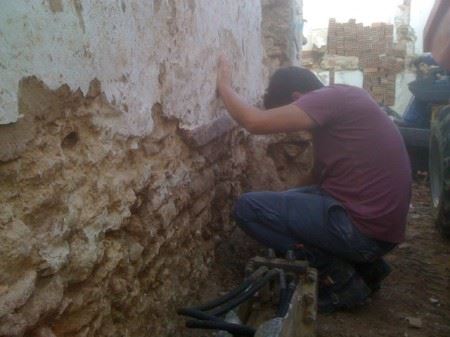 By now it was time to call on the long-awaited archaeologist. Notebook, mini brushes and putty knives in hand, he came to observe the digging, stopping the mechanical claw every time he saw a hint of something that could resemble a dead Moor or anything else worth saving. Day after day he came, picking away at the ground like a spoilt child at breakfast, and leaving walls and floors as clean enough to eat from. At long last a week later he packed up his brushes and putty knives and offered us his findings. Nothing!Nada! A few chicken bones, some pottery shards and a rusty tool-head was all he had unearthed, and a rather hefty bill. Clearly we understood that if he only could do a job at a time, he had to make as much out of the spectacle as possible. Of course the answer was NO to our next question. We could not go on with the construction before his written report had been sent to the town hall and onto the culture department, to be read, debated, hopefully approved and sealed and signed with many signatures before being couriered back to Ronda, in triplicates.
By now it was time to call on the long-awaited archaeologist. Notebook, mini brushes and putty knives in hand, he came to observe the digging, stopping the mechanical claw every time he saw a hint of something that could resemble a dead Moor or anything else worth saving. Day after day he came, picking away at the ground like a spoilt child at breakfast, and leaving walls and floors as clean enough to eat from. At long last a week later he packed up his brushes and putty knives and offered us his findings. Nothing!Nada! A few chicken bones, some pottery shards and a rusty tool-head was all he had unearthed, and a rather hefty bill. Clearly we understood that if he only could do a job at a time, he had to make as much out of the spectacle as possible. Of course the answer was NO to our next question. We could not go on with the construction before his written report had been sent to the town hall and onto the culture department, to be read, debated, hopefully approved and sealed and signed with many signatures before being couriered back to Ronda, in triplicates.
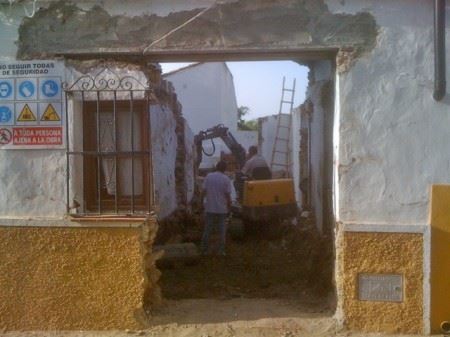 Relatively speaking, we were lucky. He could have found human remains, grave posts from Moorish times or worse still, Roman coins, mosaics or column pieces? That could have stopped our dig for good. Such treasures have been found in many houses in our barrio, many quickly covered up or secretly displayed in inner courtyards. At least, with no dead Moors in site, we knew that the construction of our house could finally begin. It was just a matter of time.
Relatively speaking, we were lucky. He could have found human remains, grave posts from Moorish times or worse still, Roman coins, mosaics or column pieces? That could have stopped our dig for good. Such treasures have been found in many houses in our barrio, many quickly covered up or secretly displayed in inner courtyards. At least, with no dead Moors in site, we knew that the construction of our house could finally begin. It was just a matter of time.
But that is a story for another day…
